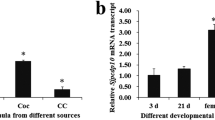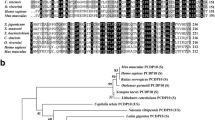Abstract
Apoptosis is a normal process for regulating cellular death of many organisms. Here, we molecularly characterized an inhibitor of apoptosis from Schistosoma japonicum (SjIAP). The transcription of the SjIAP predominantly occurred at the developmental stages in a final host. Functional assay indicated that the SjIAP could inhibit caspase activity either in 293T cell or in schistosome lysates. Additionally, there were differently expressed profiles of the SjIAP in S. japonicum living in different hosts. Our preliminary results suggest that the SjIAP may play important roles in parasitic living and development as well as in the host–parasite interactions, and drug target of SjIAP might be a potential for controlling schistosomiasis.







Similar content being viewed by others
References
Berriman M, Haas BJ, LoVerde PT, Wilson RA, Dillon GP, Cerqueira GC, Mashiyama ST, Al-Lazikani B, Andrade LF, Ashton PD, Aslett MA, Bartholomeu DC, Blandin G, Caffrey CR, Coghlan A, Coulson R, Day TA, Delcher A, DeMarco R, Djikeng A, Eyre T, Gamble JA, Ghedin E, Gu Y, Hertz-Fowler C, Hirai H, Hirai Y, Houston R, Ivens A, Johnston DA, Lacerda D, Macedo CD, McVeigh P, Ning Z, Oliveira G, Overington JP, Parkhill J, Pertea M, Pierce RJ, Protasio AV, Quail MA, Rajandream MA, Rogers J, Sajid M, Salzberg SL, Stanke M, Tivey AR, White O, Williams DL, Wortman J, Wu W, Zamanian M, Zerlotini A, Fraser-Liggett CM, Barrell BG, El-Sayed NM (2009) The genome of the blood fluke Schistosoma mansoni. Nature 460(7253):352–358
Capron A, Dessaint JP (1989) Molecular basis of host–parasite relationship: towards the definition of protective antigens. Immunol Rev 112:27–48
Chen L, Rao KV, He YX, Ramaswamy K (2002) Skin-stage schistosomula of Schistosoma mansoni produce an apoptosis-inducing factor that can cause apoptosis of T cells. J Biol Chem 277(37):34329–34335
Cheng G, Davis RE (2007) An improved and secreted luciferase reporter for schistosomes. Mol Biochem Parasitol 155(2):167–171
Cheng GF, Lin JJ, Feng XG, Fu ZQ, Jin YM, Yuan CX, Zhou YC, Cai YM (2005) Proteomic analysis of differentially expressed proteins between the male and female worm of Schistosoma japonicum after pairing. Proteomics 5(2):511–521
Cheng G, Fu Z, Lin J, Shi Y, Zhou Y, Jin Y, Cai Y (2009) In vitro and in vivo evaluation of small interference RNA-mediated gynaecophoral canal protein silencing in Schistosoma japonicum. J Gene Med 11(5):412–421
Dewey WC, Ling CC, Meyn RE (1995) Radiation-induced apoptosis: relevance to radiotherapy. Int J Radiat Oncol Biol Phys 33(4):781–796
Elmore S (2007) Apoptosis: a review of programmed cell death. Toxicol Pathol 35(4):495–516
Kumar S, Tamura K, Nei M (2004) MEGA3: integrated software for Molecular Evolutionary Genetics. Analysis and sequence alignment. Brief Bioinform 5(2):150–163
O’Riordan MX, Bauler LD, Scott FL, Duckett CS (2008) Inhibitor of apoptosis proteins in eukaryotic evolution and development: a model of thematic conservation. Dev Cell 15(4):497–508
Richter D, Harn DA, Matuschka FR (1995) The irradiated cercariae vaccine model: looking on the bright side of radiation. Parasitol Today 11(8):288–293
Salvesen GS, Duckett CS (2002) IAP proteins: blocking the road to death’s door. Nat Rev Mol Cell Biol 3(6):401–410
Salzet M, Capron A, Stefano GB (2000) Molecular crosstalk in host–parasite relationships: schistosome– and leech–host interactions. Parasitol Today 16(12):536–540
Saule P, Adriaenssens E, Delacre M, Chassande O, Bossu M, Auriault C, Wolowczuk I (2002) Early variations of host thyroxine and interleukin-7 favor Schistosoma mansoni development. J Parasitol 88(5):849–855
Thompson JD, Higgins DG, Gibson TJ (1994) CLUSTAL W: improving the sensitivity of progressive multiple sequence alignment through sequence weighting, position-specific gap penalties and weight matrix choice. Nucleic Acids Res 22(22):4673–4680
Thornberry NA, Lazebnik Y (1998) Caspases: enemies within. Science 281(5381):1312–1316
Vicogne J, Cailliau K, Tulasne D, Browaeys E, Yan YT, Fafeur V, Vilain JP, Legrand D, Trolet J, Dissous C (2004) Conservation of epidermal growth factor receptor function in the human parasitic helminth Schistosoma mansoni. J Biol Chem 279(36):37407–37414
Wang L, Utzinger J, Zhou XN (2008) Schistosomiasis control: experiences and lessons from China. Lancet 372(9652):1793–1795
Yoshino TP, Boyle JP, Humphries JE (2001) Receptor-ligand interactions and cellular signalling at the host–parasite interface. Parasitology 123 Suppl:S143–S157
Yu F, Li Y, Liu L (2008) Comparative genomics of human-like Schistosoma japonicum genes indicates a putative mechanism for host-parasite relationship. Genomics 91(2):152–157
Zhou Y, Zheng H, Liu F, Hu W, Wang ZQ, Gang L, Ren S (2009) The Schistosoma japonicum genome reveals features of host–parasite interplay. Nature 460(7253):345–351
Acknowledgements
This research was in part supported by the National Basic Research Program of China (grant no. 2007CB513108), 863 High-tech Project of China (grant no. 2006AA10A207) for J. Lin, National Natural Science Foundation of China (grant no. 30901068), and Basic Foundation for Scientific Research of State-level Public Welfare Institutes of China (grant no. 2008JB18) for G. Cheng.
Author information
Authors and Affiliations
Corresponding authors
Rights and permissions
About this article
Cite this article
Peng, J., Yang, Y., Feng, X. et al. Molecular characterizations of an inhibitor of apoptosis from Schistosoma japonicum . Parasitol Res 106, 967–976 (2010). https://doi.org/10.1007/s00436-010-1752-y
Received:
Accepted:
Published:
Issue Date:
DOI: https://doi.org/10.1007/s00436-010-1752-y




